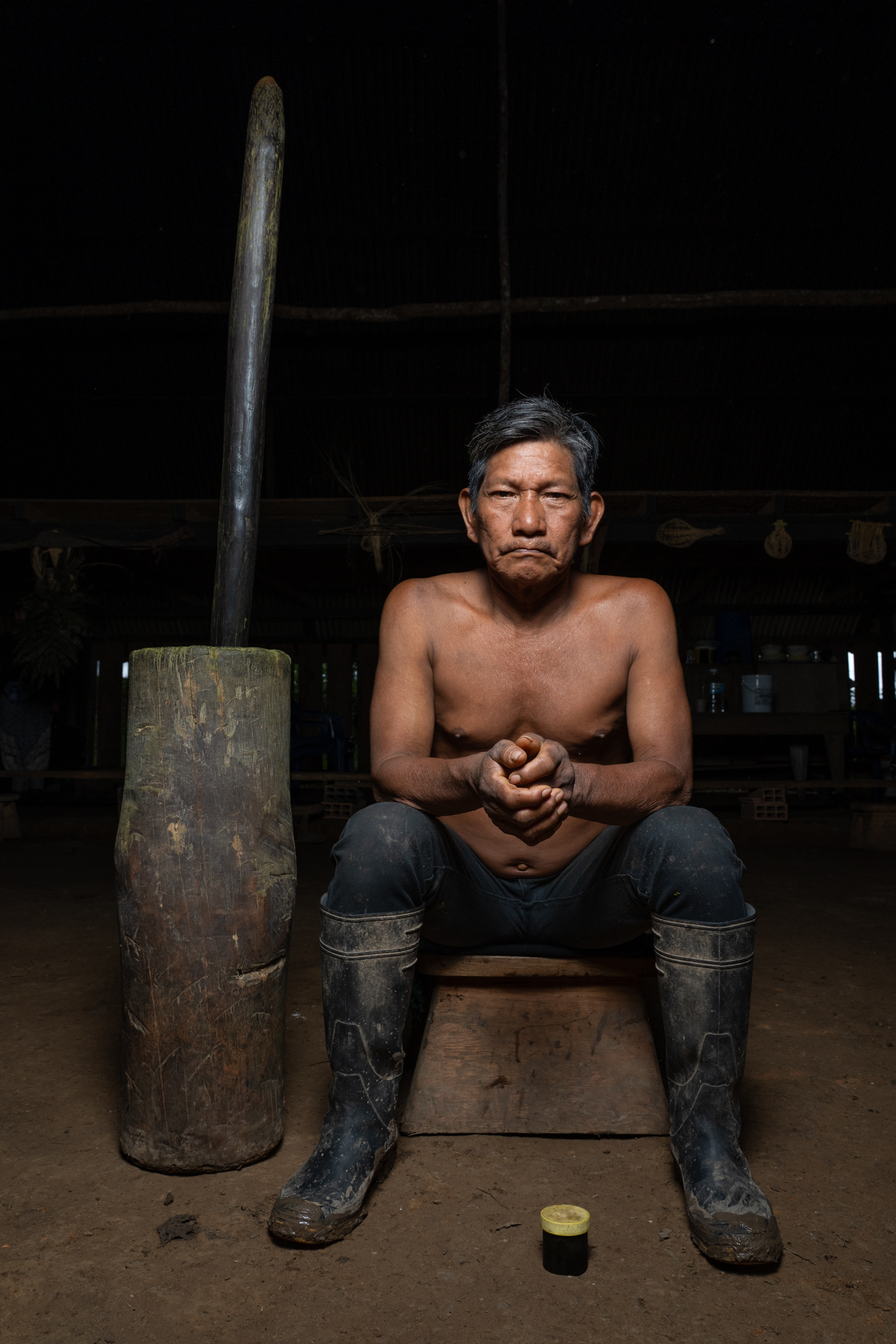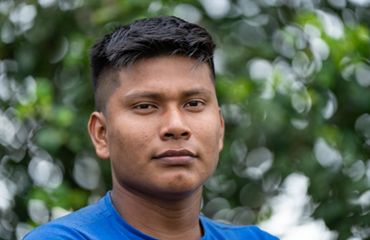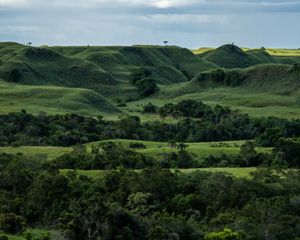
In the Colombian Amazon, the Association of Murui Muina Town Councils of the Upper Caquetá river basin (ASCAINCA in Spanish) aims to turn its traditional fruits into juices, pulps and jams while preserving the forest and its biodiversity, generating income for the community and strengthening its ancestral knowledge.
By María Camila Peña, Content Manager, TNC Latin America
“Each plant has its own spirit, and the canangucha’s is a potent and ancient one,” says Abuela (elder) Irma García from the El Quince Reserve in the Solano municipality, one of the five communities that make up the Association of Murui Muina Town Councils of the Upper Caquetá (ASCAINCA). The Abuela knew from a very early age that her vocation was to become a leader in her community; she wished to take care of everyone and communicate with all the beings in the forest. “One has to speak to them, and a lot of wisdom comes from that.”

Solano, Caquetá, is one of the municipalities with the highest biological diversity in South America and the second-largest in size in Colombia. It is also one of the most affected by deforestation.
In 2020, it had 3.83 million hectares of natural forest covering 91% of its territory. By 2024, it had lost 6,530 hectares.
Since the younger people of the El Quince ―together with five other communities started working with ASCAINCA in the Kabure project to produce juices, pulps and jams from Amazonian fruits―Abuela García and other women began weaving nets around canangucha palms (Mauritia flexuosa) in the reservation’s wetlands and swamps.
The objective was to catch the sparkly, crumbly-shelled red fruits that occasionally fall from above in the thick of harvest season in July and August and avoid their spoilage.
Harvesting is a family affair. The nimblest members climb the palms and cut the bunches from the lower parts, which can be as high as three meters. The fruits from the higher parts are left as food for birds, especially the red-bellied macaw (Orthopsittaca manilatus), a medium-sized parrot that finds this yellow-pulped fruit delicious.

The canangucha has been used by the El Quince community to quench thirst, lower fever, avoid colon problems and in the preparation of ceremonial brews, such as the canguana, used during the nights in which the community sits around the tribal chief and his advisors in the ancestral communal dwelling (maloca) to convey the words of the elders and ask the spirits of the forest for permission to take their fruits and for a clear path during the harvesting activities.

“We are known as the Canangucha clan. The Canangucha is a palm that holds water and is the one that keeps the earth cool. It reveals the territory's resistance. It represents abundance because from one plant many seeds sprout, just as our community thrives,” says Chief Dionisio Vargas.
Among his responsibilities is maintaining the abuelos’ cosmovision, and he is one of the leaders who has supported young people in their initiative to take their products to the market, allowing people from other places to learn about their history and traditions, and benefiting from the essence of life that emerges from the jungle.
Kabure, which in the Indigenous language means “breath of life,” is today a company. It is also a dream that became a reality for the communities of the Aguas Negras, Huitora, Coropoya, El Quince and Ismuina reservations (which are part of ASCAINCA). The communities are taking to market products made from Amazonian fruits that tell a living history while helping protect the forest and its biodiversity, promoting their own economy and reclaiming ancestral knowledge.
Quote: Roberto Ordoñez

We have always called the forest’s fruits the essence of life. Our elders have used them for millennia as a healthy, natural food source. What we seek with Kabure is to take to the market a product that is good for the sustainability of both humans and life itself.





Ancestral knowledge
The decision about which natural resources to use was made by the communities’ elders, based on the Territorial and Environmental Management Plans. These constitute a governance developed by Indigenous communities, enabling them to manage territorial resources in alignment with their own worldviews while preserving ecological balance.
Therefore, in addition to the canangucha, the use of other Amazonian fruits, such as açaí, guacurí and milpes, was also permitted by the elders of the communities. The Management Plans also highlighted the need to promote the leadership of young people in this process—a way for the elders to transmit their knowledge about the forest to the next generations.

“We always guide the organizational process in the maloca by talking to each other, and it was there that we saw the need to use the raw material in our territories in a renewable way. We are applying our own knowledge system to support our company, to benefit and feed our families, who are part of the ASCAINCA association, and we are doing it without harming the forest,” explains Ordoñez.
Harvesting is based on the traditional ecological calendars of each community, which measure time in cycles and determine the best times for sowing, growing and harvesting each fruit. The fruits are transported along the river by boat from each reservation to the urban center of Solano, where the Kabure Amazonian fruit processing plant is located.
There, members of the communities have begun training with specialized technicians in the agro-industrial transformation of non-timber forest products, merging traditional and Western knowledge.
Quote: Sebastián Vargas

We want to show that we, Indigenous Peoples, can also have our own businesses, following the principles of our culture, our management, our traditions, without losing sight of our purpose, which is to protect nature to keep the planet alive.
Local economies that protect biodiversity and culture
Throughout this process, The Nature Conservancy (TNC) has supported Indigenous communities in developing the company, its brand design and marketing strategy, providing them with skills in content production and sales, as well as strengthening new community leadership.
“We are joining forces with Agrosolidaria in the proceedings before the National Institute for Food and Drug Surveillance (INVIMA) and in developing quality and safety standards for production systems so that products can have a place in the market and be truly competitive,” says Adriana Correa.
Correa, a member of the community-led conservation team at TNC Colombia, has been leading the project along with the five communities that are part of ASCAINCA. For the last 12 years, TNC has developed various strategies (link in Spanish) to amplify the voice, choice and action in communities within the Caquetá River Basin, including the updating of their Management Plans.


The objective is for Kabure to become a viable economic model for the communities. This business protects nature and its biodiversity while also valuing the wisdom of the guardians of the territory. “This is a holistic approach that we at TNC know as socio-bioeconomy, which has these three key elements that achieve a balance between the social, biological and financial aspect,” explains Correa.
Quote: Justina Gómez
Before, we made our living from our chagra alone, selling our products as Indigenous Peoples. This initiative helps our families advance and gets our fruits known out there. Because they are natural, they are of exceptionally high quality and offer many benefits to those who consume them.
In a municipality like Solano, which is one of the largest and most biodiverse of Colombia, but also one of the most affected by deforestation, Kabure is a breath of life that emerges from the forest. It is also a symbol of nature’s resistance and adaptation to extreme climate change (from rain to drought), and its cycles that allow fruits to bloom again, along with the Indigenous communities that have managed and protected these territories with their wisdom for thousands of years.
Socio-bioeconomy to conserve the Amazon
TNC has been working hand in hand with Indigenous and local communities in the Amazon basin to strengthen socio-bioeconomic projects. This is a holistic model of economic development that fosters economies of abundance and well-being led by Indigenous peoples and local communities, promoting social inclusion and equity while conserving biodiversity and ecosystems, mitigating climate change and enhancing community resilience in the face of climate change.
Global Insights
Check out the latest perspectives, research and tools that inform how we protect land and waters and approach environmental challenges.



